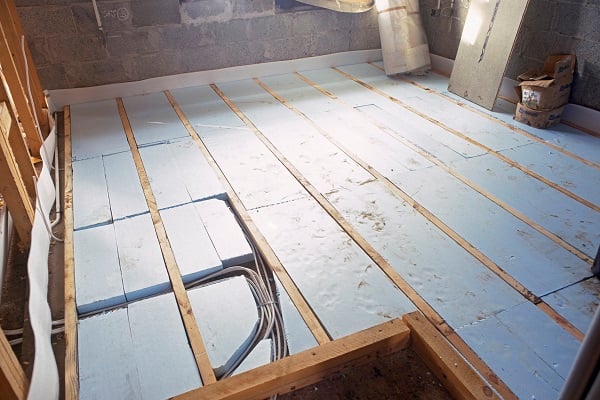Underfloor insulation is a method of insulating a building that involves adding insulating materials beneath the floor surface. The main function of this insulation is to prevent heat loss from the floor and to maintain the temperature inside the building during cold weather. It’s a vital part of the building’s thermal envelope, which includes the walls, roof, windows, and doors.
In recent years, underfloor insulation has become increasingly popular as homeowners and builders alike recognise its potential for improving comfort and energy efficiency. Despite being out of sight, this insulation plays a significant role in maintaining temperature levels and contributes to the overall energy efficiency of a home or building. You can find out more at https://q-bot.co/.
This type of insulation works by slowing down the transfer of heat between the floor and the ground or outside air, which can be particularly useful in colder climates. It may be installed during construction or retrofitted in existing structures by a suspended floor insulation robot. The type and thickness of the insulation material used will depend on several factors, including the type of flooring, the climate, and the desired level of comfort and energy efficiency.
Why is underfloor insulation important?
Underfloor insulation is important for several reasons. Firstly, it provides a barrier between the cold ground and the warm interior of a building, helping to keep the inside temperature stable. This is particularly important in colder climates where heat loss through the floor can significantly contribute to the overall heating requirements of a building.
Secondly, underfloor insulation helps to reduce the amount of energy needed to heat a building, saving on heating costs and reducing carbon emissions. By trapping heat within the building, this type of insulation can help to reduce the amount of fuel that is needed to maintain a comfortable temperature.
Lastly, underfloor insulation can improve the comfort levels inside a building. Cold floors can be uncomfortable to walk on, especially in the winter months. By insulating the floor, the temperature of the floor surface can be increased, making it more comfortable to walk on.
The science behind underfloor insulation
The effectiveness of underfloor insulation lies in its ability to slow down the transfer of heat. Heat naturally moves from warmer areas to cooler ones. In a building without underfloor insulation, heat from the interior will naturally move towards the colder ground, leading to heat loss.
Insulation materials work by trapping tiny pockets of air within their structure. These pockets slow down the transfer of heat, keeping the warm air inside the building and preventing the cold air from the ground from penetrating the floor surface. The more effective the insulation material is at trapping air, the better it will be at insulating the floor.
The performance of insulation is measured in terms of its thermal resistance, or ‘R-value‘. The higher the R-value, the more effective the insulation. The R-value depends on the type of material used, its thickness, and its density. It’s important to choose an underfloor insulation material with a suitable R-value for the climate and the type of building.
Types of underfloor insulation
There are several types of underfloor insulation available, each with their own advantages and disadvantages. The most common types include blanket insulation, loose-fill insulation, and rigid board insulation.
Blanket insulation is usually made from mineral wool, fibreglass, or sheep’s wool. It is easy to install and is usually the most cost-effective option. However, it can be less efficient than other types of insulation and may not be suitable for all types of floor construction.
Loose-fill insulation is made from materials such as cellulose, mineral wool, or polystyrene beads. It is often used in existing buildings where it can be blown into the underfloor space. It can be very effective, but it can also settle over time, reducing its insulation performance.
Rigid board insulation is made from materials such as polystyrene or polyurethane. It is highly efficient and can be used in all types of floor construction. However, it can be more expensive than other types of underfloor insulation and may require professional installation.
The best way to insulate a floor
The best way to insulate a floor will depend on several factors, including the type of floor construction, the climate, and the budget.
In a new build, the insulation can be installed during construction, either between the floor joists or below the concrete slab. In an existing building, the insulation may be installed from the crawlspace or basement, or it may be blown into the underfloor space.
Regardless of the method of installation, it’s important to ensure that the insulation is installed correctly and that there are no gaps or draughts. It’s also important to consider the moisture levels in the underfloor space as this can affect the performance of the insulation.
Benefits of insulated flooring
Insulated flooring offers several benefits. Firstly, it can significantly improve the comfort levels inside a building. By insulating the floor, the temperature of the floor surface can be increased, making it more comfortable to walk on.
Secondly, insulated flooring can help to reduce energy costs. By preventing heat loss through the floor, it can help to reduce the amount of energy needed to heat a building.
Lastly, insulated flooring can help to reduce carbon emissions. By reducing the amount of energy needed to heat a building, it can also help to reduce the amount of carbon dioxide that is released into the atmosphere.
Maintenance and care for underfloor insulation
Underfloor insulation is generally low maintenance. However, it’s important to check it regularly for any signs of damage or deterioration. If the insulation becomes damp or damaged, it can lose its insulating properties.
It’s also important to ensure that the underfloor space is adequately ventilated. This helps to prevent the buildup of moisture, which can lead to dampness and mould growth and can also affect the performance of the insulation.
If the insulation does need to be replaced, it’s usually best to hire a professional. They will have the necessary expertise and equipment to install the insulation correctly and safely.
Conclusion: The impact of underfloor insulation on energy efficiency
In conclusion, underfloor insulation can have a significant impact on the energy efficiency of a building. By reducing heat loss through the floor, it can help to reduce energy costs and carbon emissions. It can also improve the comfort levels inside a building, making it more pleasant to live or work in.
Whether you’re building a new home or looking to improve the energy efficiency of an existing building, underfloor insulation is a worthwhile investment. By considering the type of floor construction, the climate, and the budget, you can choose the best underfloor insulation for your needs.
So, don’t underestimate the power of a well-insulated floor. It’s an essential element of a well-insulated home or building and can make a significant difference to both your comfort and your energy bills.






Leave a Comment